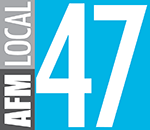Live Music During the 'Golden Era' of Hollywood
Live Music During the 1940s - 1960s
Hollywood’s rich history has many layers and aspects, and certainly one of those is the legacy of live music performances. Nowhere is this more evident than during the “Golden Era” of Hollywood. During this time period, Local 47 musicians could be found playing at such legendary venues at the Cocoanut Grove, a premier nightclub venue inside the historic (and now gone) Ambassador Hotel. Other famous locales of this time were The Brown Derby, the Palladium, and the Pig ’N Whistle, to name a few. During World War II, Local 47 musicians were heard around the globe, in groups like the Army Air Forces Radio Production Unit, who produced music that was broadcast overseas by the Office of War Information. In 1943, the area was divided into six districts, with four Local 47 business representatives overseeing the areas.
By 1953, the number of representatives had expanded to eight. The Local’s members continued to entertain Los Angeles, at clubs like Ciro’s and Mocambo on the world famous Sunset Strip. Members also continued to play at other well-recognized places like the Greek Theatre. The Los Angeles Flute Club, formed in 1916, continued its storied history, performing as one of the oldest clubs of its kind in the world. Members also took part in a live band jamboree at MacArthur Park, drawing a crowd of 6,000 listeners. A large and historic part of the Los Angeles music scene during this time was Central Avenue, a center for jazz music into the mid-1950s. Local members could also be found in Hermosa Beach at Howard Rumsey’s world famous Lighthouse. It would become a legendary jazz venue over the years, drawing crowds from all over Los Angeles to hear local artists play.
The Local would continue its tradition of bringing live outdoor music to the area in the 1960s. Working with The Music Performance Trust Funds of the Recording Industry and the L.A. Bureau of Music, Department of Parks and Recreation, the Live Music in the Parks program was formed. Concerts were held throughout the area during the summer, culminating with a Country Music Jamboree at MacArthur Park at summer’s end.
As the sounds changed over the years, so did the places Local 47 members would play. Shelly’s Manne Hole welcomed both jazz and classical sounds in the 1960s. Dante’s Jazz Club on Lankershim Boulevard was another hot spot for jazz music in the area. Other places to gather for live music in the city had an eclectic range, from the Sportsmen’s Lodge to the Biltmore and Beverly Hilton Hotels. Go-go music rose in popularity in clubs like the Trip and Hollywood A Go-Go. The Woman’s Chamber Music Society continued to play, and the High Hatters performed for local children. Local 47 members also continued their support of our armed forces, playing in Les Brown’s band with Bob Hope in Vietnam. By 1964, nine business representatives now covered the Los Angeles area.
Eight representatives would cover live music engagements near the end of the 1970s, but the picture would begin the change as we entered the 1980s. Fewer casual engagements at night clubs and hotels would take place, or be reported. The balance of live music to recorded sessions would shift into the studios. Symphonic organizations like the Los Angeles Philharmonic continued to provide live music in the area, but the landscape had changed.
One thing that remains constant, however, is the enduring legacy that Los Angeles musicians forged during the “Golden Era” of Hollywood, filling some of the most legendary nightclubs and hotels of the era with their music.
